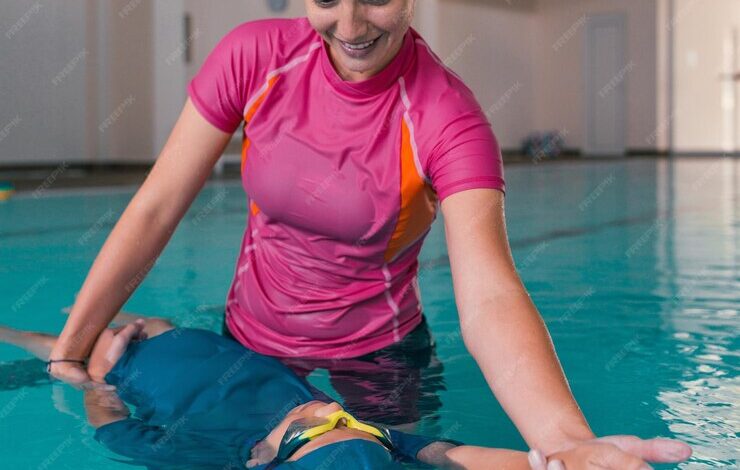Navigating Recovery: How Swimming Can Be a Game-Changer for Knee Injuries

Icing your throbbing knee, sleepless nights, and a constant ache – knee injuries can be a real pain (quite literally). If you’re currently wading through the murky waters of recovery, you might wonder, “Can swimming help with a knee injury?” The answer is a resounding yes! Swimming offers a unique set of benefits that can significantly accelerate your path to healing.
Taking the Weight Off: The Magic of Buoyancy
One of the biggest hurdles in recovering from a knee injury is the stress placed on the joint during everyday activities. Walking, running, or climbing stairs can exacerbate pain and hinder progress. This is where Swimming steps in as a superhero. The buoyancy of water takes the brunt of your body weight off your joints, reducing pressure and allowing for pain-free movement. Consider it a temporary state of weightlessness for your knees! This allows for gentle exercise and rehabilitation without the risk of further injury. Can swimming help with a knee injury? Absolutely, by providing a low-impact environment that promotes healing.
Building Strength: The Power of Aquatic Exercise
Swimming is about more than just floating around aimlessly. The water’s natural resistance creates a gentle yet effective form of exercise. Every stroke you take engages various muscle groups, particularly those that support your knee joint. Over time, this aquatic exercise strengthens the muscles around your knee, improving stability and reducing the likelihood of future injuries. Think of it as building a more robust support system for your knee. Can swimming help with a knee injury? By strengthening the surrounding muscles, swimming helps your knee function optimally.
Enhancing Flexibility: Moving with Ease
Knee injuries often lead to stiffness and a restricted range of motion. Here, too, swimming comes to the rescue. The gentle movements involved in various swimming strokes help to improve flexibility in your knee joint. As you glide through the water, your knees move through a broader range of motion, promoting greater ease and reducing stiffness. Imagine swimming as a way to gently coax your knee back into its full range of motion. Can swimming help with a knee injury? By improving flexibility, swimming allows for pain-free movement and a return to your favorite activities.
Reducing Pain and Inflammation: The Soothing Benefits of Water
The therapeutic properties of water should be considered. The cool water surrounding your knee can have a natural analgesic effect, reducing pain and inflammation. Additionally, the water’s hydrostatic pressure can help improve circulation, promoting faster healing. Think of swimming as a giant cold compress that soothes your aching knee. Can swimming help with a knee injury? Swimming allows for a more comfortable recovery process by reducing pain and inflammation.
Getting Started with Aquatic Therapy
While swimming offers many benefits, consulting with a healthcare professional before diving in is crucial, especially if your injury is severe. They can assess your specific condition and recommend a personalized aquatic therapy program. Remember, starting slow and gradually increasing intensity is critical.
Safety First: Essential Tips for Swimming with a Knee Injury
Swimming might seem like a natural fit for knee recovery, but there are a few precautions to remember. Here are some essential tips to ensure a safe and successful aquatic therapy experience:
- Warm-Up and Cool-Down: Like any other exercise routine, a proper warm-up and cool-down are crucial. Before entering the water, gentle stretches help prepare your muscles for movement, while post-swim stretches improve flexibility and prevent stiffness.
- Proper Form Matters: Swimming with the wrong technique can put undue stress on your joints. Consider consulting a swimming instructor or physical therapist to ensure you’re performing each stroke with proper form, maximizing the benefits and minimizing any potential risks.
- Listen to Your Body: Pain is your body’s way of communicating. Stop immediately if you experience discomfort during your swim and consult your healthcare professional. Remember, progress over perfection is critical.
- Gear Up for Support: Certain aquatic equipment can enhance your swimming experience and provide additional support for your injured knee. Pool noodles can help you stay afloat while focusing on leg movements, and kickboards can keep your upper body stable while isolating your core and leg muscles.
Beyond the Pool: Exercises to Complement Your Swim Routine
While swimming is a fantastic exercise for knee recovery, incorporating some land-based exercises can further strengthen the muscles surrounding your knee and improve overall stability. Here are a few exercises to consider, but remember to consult with a healthcare professional before starting any new program:
- Straight Leg Raises: Lie on your back with one Leg extended and the other bent at the knee. Slowly raise the straight Leg towards the ceiling, keeping your knee straight and toes pointed. Hold for a few seconds, then lower back down. Repeat with the other Leg.
- Wall Squats: Stand with your back against a wall and feet shoulder-width apart. Slowly slide down the wall like sitting in a chair, keeping your back straight and core engaged. Hold the squat for a few seconds, then push back to the starting position.
- Calf Raises: Stand on the balls of your feet, then slowly lower your heels down until you feel a stretch in your calves. Push back up to the starting position. You can perform this exercise barefoot, with weights, or while holding onto a chair for support.
Conclusion
If you’re recovering from a knee injury, consider taking the plunge into the world of swimming. Hipkneeortho strongly believes that swimming can be a game-changer in your recovery journey. With its low-impact nature, muscle-strengthening properties, and pain-relieving benefits, swimming can help you get back on your feet faster and more robust.
FAQs
Can swimming help with knee pain?
Yes, swimming is a low-impact exercise that can help to reduce pain and inflammation in the knee joint.
Is swimming good for a torn meniscus?
While swimming can benefit some knee injuries, consulting with a healthcare professional before starting any exercise program is essential, especially for a torn meniscus.
What are some excellent swimming exercises for knee injuries?
Many different swimming exercises can be helpful for knee injuries. A physical therapist can create a personalized program based on your specific needs.




